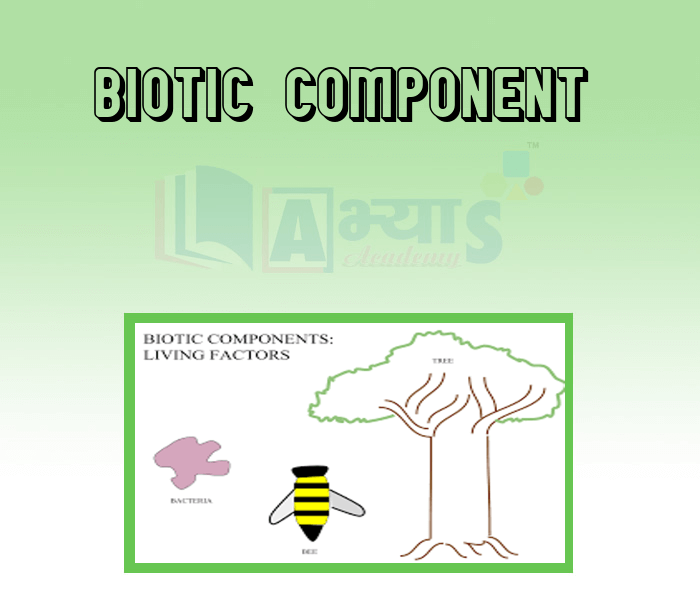Biotic Component


Biotic Component
Biotic Component:
The biotic, or living, component of an ecosystem can be classified on the basis of how the organisms get their food, i.e., whether they are producers, consumers or decomposers.
Producers:
Organisms which make their own food are called producers. They are also called autotrophs. All green plants and certain blue-green algae act as food producers in ecosystems.
Consumers:
Organisms that depend on other organisms for food are called consumers or heterotrophs. All animals which eat plants or other animals are consumers. Bacteria and fungi that depend on dead plants and animals for food are also in a way consumers. Consumers can be classified as herbivores, carnivores and omnivores. Herbivores eat only plants and plant products. Cows, deer and rabbits are herbivores. Carnivores eat only the flesh of other animals. Tigers, snakes and hawks are carnivores. Omnivores eat plants as well as the flesh of other animals. Man and crow are examples of omnivores.
Sometimes it is useful to classify the consumers in an ecosystem on the basis of ‘who eats whom’.
Primary consumers are those who feed directly on the producers (plants). Carnivores who feed on plant-eating animals (herbivores) are secondary consumers. For example, a grasshopper that feeds on plants is a primary consumer, and the frog that eats the grasshopper is a secondary consumer. The frog could be eaten by a larger carnivore like a snake. A carnivore that feeds on smaller carnivores is called a tertiary consumer. This consumer may be eaten by the largest carnivore, or the top carnivore, of the ecosystem. The top carnivore is not killed and eaten by other animals of the ecosystem. The top carnivore belongs to a higher order of consumers.
Decomposers:
Organisms which feed on dead plants and animals are called decomposers. Decomposers are also called saprotrophs or saprophytes. They include bacteria, fungi and worms. Decomposers break down (decompose) the compounds present in dead plants and animals into simpler substances and obtain nutrition from them. The substances formed in decomposition are released into the soil and the atmosphere. Thus, decomposers play an important role in the recycling of materials, replenishment of the soil’s nutrients, etc. They also clean up our surroundings by decomposing dead organisms and wastes from animals and plants.
On which of the following positions can a tiger be placed in a food chain? | |||
| Right Option : D | |||
| View Explanation | |||
The process by which plants manufacture their food is called __________________
| |||
| Right Option : B | |||
| View Explanation | |||
Flora and fauna are ___________________ | |||
| Right Option : C | |||
| View Explanation | |||
Students / Parents Reviews [10]
It was good as the experience because as we had come here we had been improved in a such envirnment created here.Extra is taught which is beneficial for future.

Eshan Arora
8thMy experience with Abhyas is very good. I have learnt many things here like vedic maths and reasoning also. Teachers here first take our doubts and then there are assignments to verify our weak points.

Shivam Rana
7thOne of the best institutes to develope a child interest in studies.Provides SST and English knowledge also unlike other institutes. Teachers are co operative and friendly online tests andPPT develope practical knowledge also.

Aman Kumar Shrivastava
10thAbhyas is a complete education Institute. Here extreme care is taken by teacher with the help of regular exam. Extra classes also conducted by the institute, if the student is weak.

Om Umang
10thBeing a parent, I saw my daughter improvement in her studies by seeing a good result in all day to day compititive exam TMO, NSO, IEO etc and as well as studies. I have got a fruitful result from my daughter.

Prisha Gupta
8thMy experience with Abhyas academy is very good. I did not think that my every subject coming here will be so strong. The main thing is that the online tests had made me learn here more things.

Hiya Gupta
8thAbout Abhyas metholodology the teachers are very nice and hardworking toward students.The Centre Head Mrs Anu Sethi is also a brilliant teacher.Abhyas has taught me how to overcome problems and has always taken my doubts and suppoeted me.

Shreya Shrivastava
8thMy experience was very good with Abhyas academy. I am studying here from 6th class and I am satisfied by its results in my life. I improved a lot here ahead of school syllabus.

Ayan Ghosh
8thA marvelous experience with Abhyas. I am glad to share that my ward has achieved more than enough at the Ambala ABHYAS centre. Years have passed on and more and more he has gained. May the centre flourish and develop day by day by the grace of God.

Archit Segal
7thIt was a good experience with Abhyas Academy. I even faced problems in starting but slowly and steadily overcomed. Especially reasoning classes helped me a lot.
